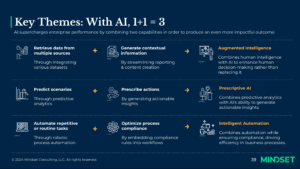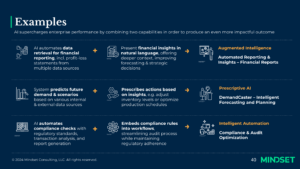In our previous article, we explored the insights and outcomes from our AI Workshop Series in collaboration with SAP. We looked at the results and common patterns from 149 use cases and how AI can boost business operations for enterprises.
In this second article, we focus on common business challenges that can be addressed by specific AI use cases across Customer Experience, Finance, Supply Chain, and IT. Finally, we demonstrate how AI is changing the way businesses work by combining capabilities that were previously not feasible but are now possible, resulting in more impactful outcomes. But first, what are the common challenges that are well-suited for AI?
Common Business Challenges
During the SAP x Mindset AI Workshop Series, participants shared several common business challenges across various industries that could benefit from Human-Centered AI (HAI). These challenges span multiple business functions, highlighting the need for greater efficiency, better data management, and process optimization:
- High manual effort & time consumption in financial processes: Tasks such as cash clearing, month-end closing, and matching payments to invoices are often manual and time-consuming, leading to inefficiencies.
- Complex data integration & data quality issues: Organizations face difficulties in consolidating data from multiple sources, leading to fragmented insights that impact the ability to make informed decisions.
- Lack of standardization & inconsistency: Financial operations and business processes often lack consistency across different departments, leading to errors and inefficiencies.
- High error rates in reporting and forecasting: Manual processes in reporting and forecasting are prone to errors, affecting the accuracy of business intelligence and compliance.
- Difficulty in navigating large datasets for decision-making: Companies struggle to manage and extract actionable insights from large, disparate datasets, impeding timely and informed decision-making.
These challenges provide a clear opportunity for businesses to leverage AI technologies, particularly in areas such as Customer Experience, Finance, Supply Chain, and IT. The top AI use cases across these functions are outlined next.
Top AI Use Cases
Here are highlights of some of the most prominent use cases from our AI workshop series:
- Customer Experience
-
-
- Data Retrieval for Customer Service Support: Streamlining interactions with quick access to customer data, orders & account info across multiple systems.
- Product Recommendation: Recommending targeted offerings through demand prediction & AI-driven insights.
-
- Finance
-
-
- Finance Process Automation for Accounts Payable: Automates repetitive tasks such as cash clearing, invoice matching & reconciliation.
- Cost Standards Setting & Pricing Optimization: Streamline the process of establishing cost benchmarks and enhance pricing strategies.
-
- Supply Chain
-
-
- Clearance Genius – Customs & Compliance Management: Streamlining customs clearance, documentation, stay updated on regulations, and optimize clearance processes, tax policies, and inspections.
- Inventory Optimization Assistant: Improving inventory planning & space utilization by predicting demand based on historical data & market trends.
-
- IT
-
- Automate Test Execution: Automate scenario testing during system upgrades for development efficiency & reduce manual effort.
- Automate Software Application Development: Automate parts of the software development process to streamline workflows & reduce enhancement cycles.
These (non-exhaustive) use cases show how AI can transform various functions from supply chain to finance to customer service and IT, but also highlight the importance of aligning AI solutions with business goals and the human experience. Although these challenges are not new, the methods with which we can approach them today are, especially with the capabilities offered by AI. The next section describes how AI is amplifying the impact of technology in solving current and future business challenges.
Combining AI Capabilities for Greater Impact
In the previous article, we described six ways AI can be used across different functions or departments within a company. What was particularly interesting was how these uses could be paired for even more impactful results, leading to three main themes: Augmented Intelligence, Prescriptive AI, and Intelligent Automation (as shown in Figure 1 and illustrated with examples in Figure 2).

The three themes that emerged from our analysis truly do underscore the impact of AI in business operations:
- Augmented Intelligence – Retrieving data and generating contextual information to enhance human decision-making. A use case that illustrates this is the Automated Reporting & Insights for Financial Reports, where AI automatically generates financial reports, including profit-loss statements, from multiple data sources. The system then presents insights in natural language, enhancing human decision-making and providing a deeper context that improves forecasting and strategic decisions.
- Prescriptive AI – Predicting scenarios and prescribing actions, offering not just forecasts but actionable guidance. A use case that reflects this capability is DemandCaster – Intelligent Forecasting and Planning, where AI improves demand forecasting accuracy by reducing manual efforts and optimizing production flow and lead time. The system predicts future demand, and based on these predictions, it prescribes actions such as adjusting inventory levels or optimizing production schedules.
- Intelligent Automation – Automating tasks and optimizing compliance results, improving efficiency while ensuring compliance. An example of this capability is Compliance & Audit Optimization, where AI automates compliance checks, transaction analysis, and report generation, ensuring that organizations stay compliant with regulatory standards. By embedding compliance rules into workflows, AI not only streamlines the audit process but also increases efficiency while maintaining high standards of regulatory adherence.

Having explored the promises of AI through these key themes, our next article will dive into the implications for organizations looking to implement AI and drive their business transformation. In the meantime, take a closer look at the top AI and Gen AI use cases, alongside the business challenges they address, in our detailed research report, and also how we at Mindset can help organizations unlock AI’s potential with human-centered design.
We’d love to hear your thoughts and ideas—whether you’re curious about how these use cases could apply to your business or simply want to bounce around some ideas. Reach out to us, and let’s start a conversation. We’re always excited to exchange insights and explore how we can help you realize the impact of human-centered AI in your organization.